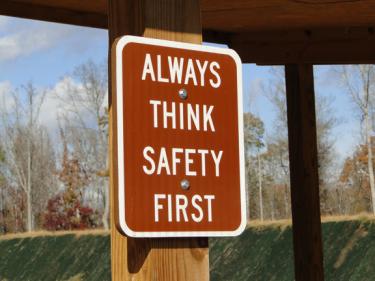Trail Safety
Spending time in your woods brings many rewards, but also a few hazards. The sun, insects, poisonous plants and even wild animals can quickly turn a hike from good to bad, especially when children are involved. So before you head for the trails, use these tips to keep yourself and your family safe.
General tips
- Wear long-sleeve shirts and pants and sturdy shoes. Use this handy guide to select the right footwear for your needs.
- Bring rain gear if you’re going to be out for a while.
- Leave your itinerary with a friend or family member and check in with them upon your return.
- Carry a map and a compass.
- Bring a first aid kit. For tips on what to include, use this checklist from the American Hiking Society (AHS).
- Also pack a whistle, pen knife, flashlight, batteries, fire-starter and matches.
- Pace yourself: Start out slowly and rest frequently.
- Drink plenty of water.
- Pack snacks such as trail mix or fruit.
- Don’t forget your mobile phone (fully charged and programmed with emergency numbers).
Sun
- Wear sunglasses and a hat.
- Bring sunscreen -- no matter the season.
Insects
Apply insect repellant to exposed skin. The Centers for Disease Control (CDC) recommends using repellents that contain DEET, picaridin or oil of
lemon eucalyptus.
Mosquitoes may carry West Nile Virus, which is a year-round threat in some parts of the U.S.
Ticks can transmit a variety of diseases, including Lyme disease, and are also a year-round threat. Avoid contact with them by wearing pants, socks and boots, hiking in the center of trails and staying out of bushy areas with high grass and leaf litter. Use this primer to learn what ticks look like and which ones are common in your region.
After your hike, perform a tick check. Focus on the places they’re most likely to hide: under the arms, behind the knees, in and around the ears and hair, between the legs. Also check your clothing.
Watch for Yellow Jacket nests on the ground near trails.
Poisonous plants
Get to know the vegetation in your woods, including the names and photos of toxic plants. In the U.S., the most common plants that cause allergic reactions are poison ivy, oak and sumac.
Don’t eat wild plants or mushrooms.
Wildlife
While there are few predators that pose a risk to humans in North America, getting too close to a wild animal can have serious consequences. Here’s how to prevent conflicts with wildlife, such as elk, deer, moose and rattlesnakes, and what to do if you encounter a predator such as a cougar, wolf, coyote or bear.
Prevent conflicts with wildlife
- Stay vigilant. As you hike, look out for signs of animals in the area, including tracks, droppings, carcasses or other food sources. And make
Be sure to stay as vigilant as this vulture while spending time in your woods.sufficient noise to let animals know you’re in their midst. Most animals are shy of humans and will move out of your way.
- Stay on the trail. One of the most common causes of bear attacks while hiking is veering off trail or hiking at night. You’re also less likely to encounter rattlesnakes, which sense vibration and tend to hide in thick brush, and behind logs and rocks, on a trail.
- Supervise children. They’re curious, confident and don’t always understand the consequences of their actions. So keep your kids in sight at all times and don’t let them fall behind.
- Hike in a group. There’s safety in numbers.
- Keep your dogs on a leash.
- Avoid leaving food and garbage on the trail. In addition to food scraps and leftovers, coolers, empty cans, dishwater, toothpaste and pet food and dishes can attract wildlife to your favorite lunch stop or viewpoint.
- Keep your distance. A good rule of thumb is to stay 30 meters (3 bus lengths) away from deer, elk, moose and goats, and 100 meters (10 bus lengths) from bears, cougars and wolves. Use a camera with a telephoto lens or binoculars to view wildlife instead. Wild animals, even those that seem unbothered by your presence, can behave in unpredictable ways.
If you encounter a predator
- Pick up small children immediately.
- Yell.
- Do anything you can to make yourself look bigger.
- Back away slowing, without turning your back to the animal.
- Be prepared to use pepper spray if you have it.
- Fight back aggressively if attacked.
- Do not crouch, play dead, run or make sudden movements.
How can I get more tips?
It’s simple! Enter your email below.



